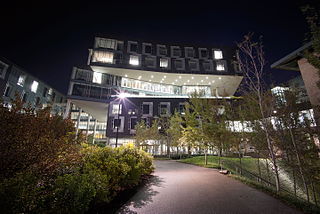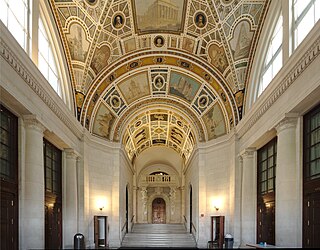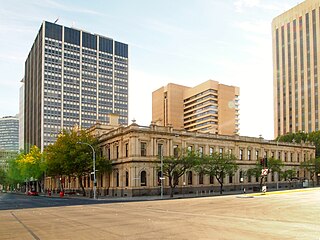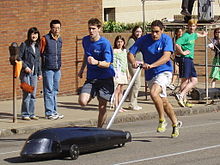
Carnegie Mellon University (CMU) is a private research university in Pittsburgh, Pennsylvania. The institution was originally established in 1900 by Andrew Carnegie as the Carnegie Technical Schools. In 1912, it became the Carnegie Institute of Technology and began granting four-year degrees. In 1967, it became the current-day Carnegie Mellon University through its merger with the Mellon Institute of Industrial Research, founded in 1913 by Andrew Mellon and Richard B. Mellon and formerly a part of the University of Pittsburgh.

The Heinz College of Information Systems and Public Policy, also known as Heinz College, is the public policy and information college of Carnegie Mellon University in Pittsburgh, Pennsylvania. It consists of the School of Information Systems and Management and the School of Public Policy and Management. The college is named after CMU's former instructor and the later U.S. Senator John Heinz from Pennsylvania.

The School of Computer Science (SCS) at Carnegie Mellon University in Pittsburgh, Pennsylvania, US is a school for computer science established in 1988. It has been consistently ranked among the top computer science programs over the decades. As of 2022 U.S. News & World Report ranks the graduate program as tied for second with Stanford University and University of California, Berkeley. It is ranked second in the United States on Computer Science Open Rankings, which combines scores from multiple independent rankings.

Dabbala Rajagopal "Raj" Reddy is an Indian-born American computer scientist and a winner of the Turing Award. He is one of the early pioneers of artificial intelligence and has served on the faculty of Stanford and Carnegie Mellon for over 50 years. He was the founding director of the Robotics Institute at Carnegie Mellon University. He was instrumental in helping to create Rajiv Gandhi University of Knowledge Technologies in India, to cater to the educational needs of the low-income, gifted, rural youth. He is the chairman of International Institute of Information Technology, Hyderabad. He is the first person of Asian origin to receive the Turing Award, in 1994, known as the Nobel Prize of Computer Science, for his work in the field of artificial intelligence.
The Andrew Project was a distributed computing environment developed at Carnegie Mellon University beginning in 1982. It was an ambitious project for its time and resulted in an unprecedentedly vast and accessible university computing infrastructure. The project was named after Andrew Carnegie and Andrew Mellon, the founders of the institutions that eventually became Carnegie Mellon University.

Schenley Park is a large municipal park in Pittsburgh, Pennsylvania. It is located between the neighborhoods of Oakland, Greenfield, and Squirrel Hill. It is also listed on the National Register of Historic Places as a historic district. In 2011, the park was named one of "America's Coolest City Parks" by Travel + Leisure.
Jared Leigh Cohon served as the eighth president of Carnegie Mellon University in Pittsburgh, Pennsylvania, United States. As of 2014 he is a University Professor in the Carnegie Mellon College of Engineering.

The College of Fine Arts (CFA) at Carnegie Mellon University in Pittsburgh, in the U.S. state of Pennsylvania oversees the Schools of Architecture, Art, Design, Drama, and Music along with its associated centers, studios, and galleries.

Carnegie Mellon Silicon Valley is a degree-granting branch campus of Carnegie Mellon University located in the heart of Silicon Valley in Mountain View, California. It was established in 2002 at the NASA Ames Research Center in Moffett Field.

Carnegie Mellon University in Qatar, is one of the degree-granting branch campuses of Carnegie Mellon University, located in Doha, Qatar. It is Carnegie Mellon's first undergraduate branch campus, is a member of the Qatar Foundation, and began graduating students in May 2008.

Scotch'n'Soda is a student-run theatre organization that resides on the campus of Carnegie Mellon University. Its initial dedication was the creation and production of original musicals, but has now taken to performing both professionally published and student-written materials. Students are welcome to write, compose, design, direct, perform in, and otherwise become involved with every aspect of each production. The organization is open to all Carnegie Mellon students from all backgrounds who are interested, and all performances are public with varying ticket prices.

Carnegie Mellon University in Australia is the Australian campus of Carnegie Mellon University's H. John Heinz III College established in 2006 in the city centre of Adelaide, South Australia.

The Miller ICA at Carnegie Mellon University is the contemporary art gallery of Carnegie Mellon University in Pittsburgh, Pennsylvania.

Subra Suresh is an Indian-born American bioengineer, materials scientist, and academic. On 1 January 2018, he was inaugurated as the fourth President of Singapore's Nanyang Technological University (NTU), where he is also the inaugural Distinguished University Professor. Subra Suresh plans on stepping down from his role as the President of NTU at the end of 2022. He was the Vannevar Bush Professor of Engineering at the Massachusetts Institute of Technology (MIT), and Dean of the School of Engineering at MIT from 2007 to 2010 before being appointed as Director of the National Science Foundation (NSF) by Barack Obama, where he served from 2010 to 2013. He was the president of Carnegie Mellon University (CMU) from 2013 to 2017.
The traditions of Washington & Jefferson College are a key aspect of the culture of Washington & Jefferson College. One of the oldest traditions at Washington & Jefferson College were the "Freshman Rules", a system of rules and restrictions on freshmen. Failure by freshmen to follow these rules would subject them to beatings by upperclassmen or other punishments doled out by the "Freshman Court". During the 1870s and 1880s, the students engaged in organized athletic competitions, pitting the freshman versus sophomore classes in the "Olympic Games" that involved elaborate opening ceremonies and the smoking of a Pipe of Peace." Another form of physical contest between the freshman and sophomore classes were the annual "color rush," where the teams fought over control over strips of fabric, the "pole rush," where the teams battled to raise a flag up a flagpole, and the "cane rush" where the teams fought over control over a ceremonial cane. These contests generally devolved into outright gang violence.
The Tepper School of Business is the business school of Carnegie Mellon University. It is located in the university's 140-acre (0.57 km2) campus in Pittsburgh, Pennsylvania.

The Computational Biology Department (CBD) is a division within the School of Computer Science at Carnegie Mellon University in Pittsburgh, Pennsylvania, United States. It is located in the Gates-Hillman Center. Established in 2007 by Robert F. Murphy as the Lane Center for Computational Biology with funding from Raymond J. Lane and Stephanie Lane, CBD became a department within the School of Computer Science in 2016.

Steven Irwin Klepper was an American economics professor, researcher and author. Klepper was the Arthur Arton Hamerschlag Professor of Economics and Social Science at Carnegie Mellon University (CMU) in Pittsburgh, Pennsylvania. He was recognized for his teaching and research related to the integration of traditional economic models with evolutionary theory, and finding connections between the study of entrepreneurship and mainstream economics. In 2011, he was the recipient of the Global Award for Entrepreneurship Research. Klepper authored more than 100 peer reviewed articles generating more than 10,000 citations. He is listed in the top five percent of most influential economist authors in the world according to IDEAS/RePEc.

Farnam Jahanian is an Iranian-American computer scientist, entrepreneur, and higher education leader. He serves as the 10th president of Carnegie Mellon University.

Carnegie Mellon University Africa, in Kigali, Rwanda, is a global location of Carnegie Mellon University. CMU-Africa offers master's degrees in Information Technology, Electrical and Computer Engineering, and Engineering Artificial Intelligence. CMU-Africa is part of the Carnegie Mellon College of Engineering. The College of Engineering is top-ranked. In U.S. News & World Report's 2023 graduate rankings, the College of Engineering was ranked #4.





















